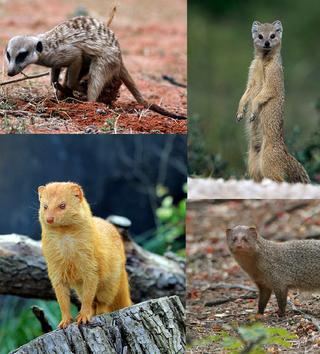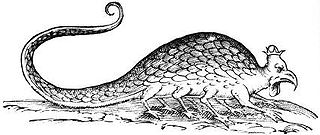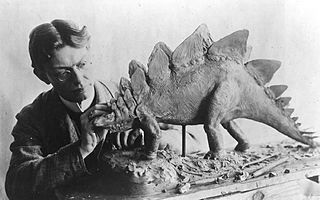
The European dragon is a legendary creature in folklore and mythology among the overlapping cultures of Europe.

A mongoose is a small terrestrial carnivorous mammal belonging to the family Herpestidae. This family is currently split into two subfamilies, the Herpestinae and the Mungotinae. The Herpestinae comprises 23 living species that are native to southern Europe, Africa and Asia, whereas the Mungotinae comprises 11 species native to Africa. The Herpestidae originated about 21.8 ± 3.6 million years ago in the Early Miocene and genetically diverged into two main genetic lineages between 19.1 and 18.5 ± 3.5 million years ago.

A cockatrice is a mythical beast, essentially a two-legged dragon, wyvern, or serpent-like creature with a rooster's head. Described by Laurence Breiner as "an ornament in the drama and poetry of the Elizabethans", it was featured prominently in English thought and myth for centuries.

The catoblepas is a legendary creature from Aethiopia, first described by Pliny the Elder and later by Claudius Aelianus.

Ophiophagy is a specialized form of feeding or alimentary behavior of animals which hunt and eat snakes. There are ophiophagous mammals, birds, lizards, and even other snakes, such as the Central and South American mussuranas and the North American common kingsnake. The venomous king cobra is also named for this habit.
Zilant is a legendary creature, something between a dragon and a wyvern. Since 1730, it has been the official symbol of Kazan. This winged snake is mentioned in legends about the foundation of Kazan.

The Book of the Dun Cow (1978) is a fantasy novel by Walter Wangerin Jr. It is loosely based upon the beast fable of Chanticleer and the Fox adapted from the story of "The Nun's Priest's Tale" from Geoffrey Chaucer's Canterbury Tales. It has two sequels.

The Egyptian mongoose, also known as ichneumon, is a mongoose species native to the tropical and subtropical grasslands, savannas, and shrublands of Africa and around the Mediterranean Basin in North Africa, the Middle East and the Iberian Peninsula. Whether it is introduced or native to the Iberian Peninsula is in some doubt. Because of its widespread occurrence, it is listed as Least Concern on the IUCN Red List.

The Indian grey mongoose or Asian grey mongoose is a mongoose species native to the Indian subcontinent and West Asia. It is listed as Least Concern on the IUCN Red List.
Medusa is either of two paintings described in Giorgio Vasari's Life of Leonardo da Vinci as being among Leonardo's earliest works. Neither painting survived.

The wildlife of the Democratic Republic of the Congo includes its flora and fauna, comprising a large biodiversity in rainforests, seasonally flooded forests and grasslands.
Chimera, originally found in Greek mythology, is a monstrous fire-breathing creature composed of the parts of multiple animals. The term, and often the general concept, has since been adopted by various works of popular culture, and chimeras of differing description can be found in contemporary works of fantasy and science fiction.

The Hydrus is a creature from Medieval bestiaries. They were said to be found in the Nile River. While in the Nile, a crocodile would roll the hydrus in the mud before eating the smaller creature. However, once inside the crocodile's stomach, the hydrus would burst free from the stomach lining. Another interpretation is that the hydrus would intentionally roll in the mud and seek out the crocodile while it slept with its mouth open. In medieval Christian tradition, this bursting free from the crocodile became an emblem of the resurrection of Christ bursting free from Hell.

In European bestiaries and legends, a basilisk is a legendary reptile reputed to be a serpent king, who causes death to those who look into its eyes. According to the Naturalis Historia of Pliny the Elder, the basilisk of Cyrene is a small snake, "being not more than twelve inches in length", that is so venomous, it leaves a wide trail of deadly venom in its wake, and its gaze is likewise lethal.

Animal mummification was common in ancient Egypt. Animals were an important part of Egyptian culture, not only in their role as food and pets, but also for religious reasons. Many different types of animals were mummified, typically for four main purposes: to allow people's beloved pets to go on to the afterlife, to provide food in the afterlife, to act as offerings to a particular god, and because some were seen as physical manifestations of specific deities that the Egyptians worshipped. Bastet, the cat goddess, is an example of one such deity. In 1888, an Egyptian farmer digging in the sand near Istabl Antar discovered a mass grave of felines, ancient cats that were mummified and buried in pits at great numbers.

The Chinese zodiac is a traditional classification scheme based on the Chinese calendar that assigns an animal and its reputed attributes to each year in a repeating twelve-year cycle. In traditional Chinese culture, the Chinese zodiac is very important and exists as a reflection of Chinese philosophy and culture. Chinese folkways held that one's personality is related to the attributes of their zodiac animal. Originating from China, the zodiac and its variations remain popular in many East Asian and Southeast Asian countries, such as Japan, South Korea, Vietnam, Singapore, Nepal, Bhutan, Cambodia, and Thailand.

Work on the conservation and restoration of Leonardo da Vinci's The Last Supper mural, much of it more harmful than helpful, has been carried out over many centuries, and continues. Completed in the late 15th century by the Renaissance artist Leonardo da Vinci, the mural is located in the refectory of the Convent of Santa Maria delle Grazie, Milan, Italy. The Last Supper was commissioned by Ludovico Sforza, Duke of Milan in 1495, as part of a series of renovations to the convent with the intention that the location would become the Sforza family mausoleum. Painting began in 1495 and continued until 1498.

Human uses of reptiles have for centuries included both symbolic and practical interactions.

The trochilus or trochilos, sometimes called the crocodile bird, is a legendary bird, first described by Herodotus, and later by Aristotle, Pliny, and Aelian, which was supposed to have enjoyed a symbiotic relationship with the Nile crocodile: it was said to pick leeches from the crocodile's throat by Herodotus, and to pick the crocodile's teeth by Aristotle. The trochilus has subsequently been spuriously identified with several bird species endemic to the Nile valley.
















